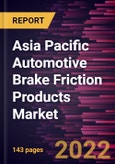The automotive brake friction products market in Asia Pacific is expected to grow from US$ 5,935.91 million in 2021 to US$ 7,985.53 million by 2028; it is estimated to grow at a CAGR of 4.3% from 2021 to 2028
The vehicle architecture is shifting with the evolution of the automobile industry, and many governments are forcing automobile manufacturers to develop safety-assurance cars. Thus, many key players and governments of several countries are investing a significant amount of capital in developing efficient and reliable automotive breaks. However, regardless of the future brake systems or vehicle architecture, brakes are the most vital driving safety components, which is boosting the automotive brake friction products market growth. Vehicle architecture is evolving with the growing automated driving capabilities. As software defines the character of cars and the driving experience in the future, digitalization and connectivity are fundamentally realigning the electrical and electronic architecture (E/E architecture) of vehicles, which is increasingly based on software. Apps and services transform the car into a fully immersive experience that steadily improves safety and comfort. The use of brakes while driving increases due to rising traffic congestion. More braking wears down the brake pads and reduces braking power. When braking power is reduced, there is a high demand for brake pads and brake shoes to be replaced. As a result of the increased use of brakes due to traffic congestion led to the changing of brakes; therefore, the demand for brake pads is rising, resulting in the automotive brake friction products market growth.
AISIN SEIKI Co.Ltd.; AKEBONO BRAKE INDUSTRY CO., LTD; Bendix Spicer Foundation Brake LLC; BOSCH Auto Parts; Carlisle Brake Friction; Delphi Auto Part; Japan Brake Industrial Co. LTD; MIBA AG; and Nisshinbo Holdings Inc are among the leading companies operating in the Asia Pacific automotive brake friction products market.
The vehicle architecture is shifting with the evolution of the automobile industry, and many governments are forcing automobile manufacturers to develop safety-assurance cars. Thus, many key players and governments of several countries are investing a significant amount of capital in developing efficient and reliable automotive breaks. However, regardless of the future brake systems or vehicle architecture, brakes are the most vital driving safety components, which is boosting the automotive brake friction products market growth. Vehicle architecture is evolving with the growing automated driving capabilities. As software defines the character of cars and the driving experience in the future, digitalization and connectivity are fundamentally realigning the electrical and electronic architecture (E/E architecture) of vehicles, which is increasingly based on software. Apps and services transform the car into a fully immersive experience that steadily improves safety and comfort. The use of brakes while driving increases due to rising traffic congestion. More braking wears down the brake pads and reduces braking power. When braking power is reduced, there is a high demand for brake pads and brake shoes to be replaced. As a result of the increased use of brakes due to traffic congestion led to the changing of brakes; therefore, the demand for brake pads is rising, resulting in the automotive brake friction products market growth.
Asia Pacific Automotive Brake Friction Products Market Segmentation
The Asia Pacific automotive brake friction products market is segmented into disc materials, product type, vehicle type, and country. Based on disc materials, the Asia Pacific automotive brake friction products market is segmented into metallic, ceramic, and composite. In 2020, the composite segment held the largest market share. Based on product type, the market is segmented into brake shoe, brake pad, brake disc, brake liner and drum brake. In 2020, the brake liner segment held the largest market share. Based on vehicle type, the market is bifurcated into passenger vehicles and commercial vehicles. In 2020, the passenger vehicles segment held a larger market share. Similarly, based on country, the Asia Pacific automotive brake friction products market is segmented into Australia, China, India, Japan, South Korea, and the Rest of Asia Pacific. Further, China contributed a substantial share in 2020.AISIN SEIKI Co.Ltd.; AKEBONO BRAKE INDUSTRY CO., LTD; Bendix Spicer Foundation Brake LLC; BOSCH Auto Parts; Carlisle Brake Friction; Delphi Auto Part; Japan Brake Industrial Co. LTD; MIBA AG; and Nisshinbo Holdings Inc are among the leading companies operating in the Asia Pacific automotive brake friction products market.
Table of Contents
1. Introduction
3. Research Methodology
4. SAM Automotive Brake Friction Products Market Landscape
5. SAM Automotive Brake Friction Products Market - Key Market Dynamics
6. Automotive Brake Friction Products Market - SAM Analysis
7. SAM Automotive Brake Friction Products Market Analysis - By Disc Materials
8. SAM Automotive Brake Friction Products Market Analysis - By Product Type
9. SAM Automotive Brake Friction Products Market Analysis - By Vehicle Type
10. SAM Automotive Brake Friction Products Market - Country Analysis
11. SAM Automotive Brake Friction Products Market-Industry Landscape
12. Company Profiles
13. Appendix
List of Figures
List of Tables
Companies Mentioned
- AISIN SEIKI Co.Ltd.
- AKEBONO BRAKE INDUSTRY CO., LTD
- Bendix Spicer Foundation Brake LLC
- BOSCH Auto Parts
- arlisle Brake Friction
- Delphi Auto Parts
- Japan Brake Industrial Co. LTD
- MIBA AG
- Nisshinbo Holdings Inc.
Table Information
| Report Attribute | Details |
|---|---|
| No. of Pages | 143 |
| Published | August 2022 |
| Forecast Period | 2022 - 2028 |
| Estimated Market Value ( USD | $ 5935.91 Million |
| Forecasted Market Value ( USD | $ 7985.53 Million |
| Compound Annual Growth Rate | 4.3% |
| Regions Covered | Asia Pacific |
| No. of Companies Mentioned | 9 |








